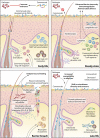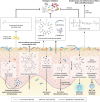Living in Your Skin: Microbes, Molecules, and Mechanisms
- PMID: 33468585
- PMCID: PMC8090955
- DOI: 10.1128/IAI.00695-20
Living in Your Skin: Microbes, Molecules, and Mechanisms
Abstract
Human skin functions as a physical, chemical, and immune barrier against the external environment while also providing a protective niche for its resident microbiota, known as the skin microbiome. Cooperation between the microbiota, host skin cells, and the immune system is responsible for maintenance of skin health, and a disruption to this delicate balance, such as by pathogen invasion or a breach in the skin barrier, may lead to impaired skin function. In this minireview, we describe the role of the microbiome in microbe, host, and immune interactions under distinct skin states, including homeostasis, tissue repair, and wound infection. Furthermore, we highlight the growing number of diverse microbial metabolites and products that have been identified to mediate these interactions, particularly those involved in host-microbe communication and defensive symbiosis. We also address the contextual pathogenicity exhibited by many skin commensals and provide insight into future directions in the skin microbiome field.
Keywords: host-microbe interaction; microbial ecology; skin microbiome; specialized metabolite; wound infection.
Copyright © 2021 Swaney and Kalan.
Figures



References
-
- Thorp T. 1901. Dr. Metchnikoff on microbes and the human body. Nature 63: 621–622.
-
- Whitfield A, Heath AD, Dore SE, Little G, Wills WK. 1904. Discussion on the relative importance of bacterial and other factors in the causation of skin diseases. Br Med J 2:986–989.
Publication types
MeSH terms
Substances
Grants and funding
LinkOut - more resources
Full Text Sources
Other Literature Sources

